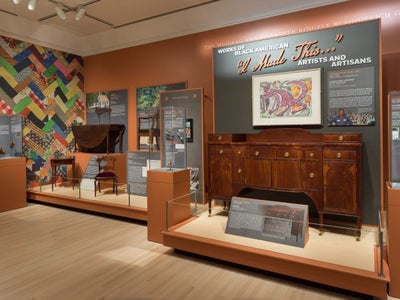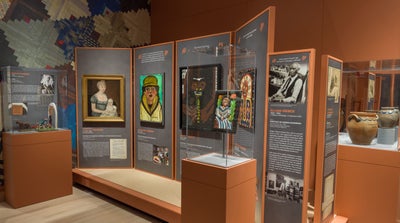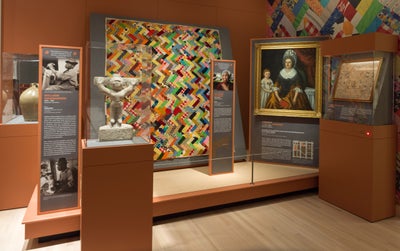
For the first time in history, the art museums of Colonial Williamsburg are offering an “exhibition of decorative and folk art collections exclusively crafted by Black artists from the 18th to 21st centuries.”
“I made this: The Work of Black American Artists and Artisans” is certainly aptly titled. David Drake, an enslaved potter during the 1800s, inscribed those very words “on one of his pots despite laws prohibiting literacy” for slaves. Of note, Drake is the only known potter at that time to date and sign his work.
In addition to the content, the curation of “I made this…” was another groundbreaking first for the Art Museums, as an advisory committee was assembled comprising colleagues from various disciplines from The Colonial Williamsburg Foundation.
 D2022-JBC-1018-0002 I Made This… exhibit preview; October 18, 2022
D2022-JBC-1018-0002 I Made This… exhibit preview; October 18, 2022
From an initial list that contained over 140 items, the committee whittled it down to the 28 pieces now available to be seen at the museum, with 13 alternates “that will be rotated in during the exhibition’s run to protect fragile and light-sensitive objects.”
This unique exhibit at the Miodrag and Elizabeth Ridgely Blagojevich Gallery of the DeWitt Wallace Decorative Arts Museum opened its doors on October 22, 2022 and viewers can flock to see this collection until December 31, 2025.
ESSENCE was fortunate enough to get an inside look, speaking with Laura Barry, a curator for the exhibition, and Ayinde Martin– who works in the historic area as a journeyman carpenter and was one of the members of the advisory committee for the exhibition– about the inspiration for this exhibition, its historical significance, and the curatorial process.
This interview has been edited for length and clarity.
ESSENCE: What was the inspiration for this exhibition?
Barry: In the past, we put together single media exhibits that feature work by African American makers—we’ve done quilt shows, but we’ve never put together a multimedia exhibit that just focuses on Black craftsmanship. In this instance, we wanted to highlight the richness in our collections and showcase about three centuries worth of material together, so that’s kind of a very new way of presenting this material over the span of time, across disciplines, and we combined things from both our decorative arts and our folk art collections into one exhibit. It’s something that we’ve been talking about for a while, and we decided to put it together about three years ago.
ESSENCE: Why do you think it’s so important to tell the stories of these makers?
Martin: Giving an opportunity [for those artists] to have a voice. You can say that someone made this specifically, someone had an opportunity to leave a piece behind, maybe even leave a message behind for someone after the fact. All of these individuals had Black skin, so to say that this story is complete [is not correct]. We cannot forget that people are still dealing with some of the evils that these individuals had to deal with when they were making these objects. Again, we have pieces from 18th century, 19th century, 20th, and 21st century and there’s a common thread that you can see in some of the objects and the reasons why they were created.
There are things that were made by enslaved hands in Williamsburg that we have in this exhibit, but there are people that never had to step foot in the tobacco field or cotton field in the 21st century, and a conversation between those two individuals over time will have common threads, and I can’t imagine the creators of those objects not wanting that to be spoken out and seen in the future.

ESSENCE: Can you tell me more about your roles in this exhibition?
Martin: I was a member of the committee, and I went through the list of objects that we had, because there was a lot of different objects we could put into the exhibit.
Barry: I curate the paintings and sculpture, which is a large part of what’s in the exhibit today.
ESSENCE: You both mentioned earlier how the curation of this exhibit is so unique in terms of the advisory group working with the curators. Can you tell me more about what that process was like and why the decision was made to do the process like that?
Martin: A lot of this is new for me being that I work in historic trades at Colonial Williamsburg, so I get to use 18th century tools and build 18th century houses in 2022. I was honored to be asked my opinion about some of the objects that we have that were made by people that are walking the same streets that I walk every day, so that was kind of cool. For me it was truly an honor to be asked to put in some thought behind what we’re going to be displaying.
Barry: It was a really extraordinary process, and I was not on that committee, but rather on the other side, the curatorial side. The specialist curators were asked to pull together any object made by a Black artist or craftsman and then the committee was really the ones to comb through those lists. We all get set in our ways on how we interpret material and how we look at things, and I will say that Colonial Williamsburg has always been focused on the material culture of objects. We’ve always been interested in the maker and the cultural context in which something was made. But in this instance, it was such a wonderful experience to be able to talk to so many people outside of our respective responsibilities.
For a committee of folks from all over the foundation to get together and talk about their perceptions on this art, I just think makes it all the richer. That’s true of anything in life, whether it’s research or exhibitions, the more voices that we have, and telling the story just makes it richer. It’s such a neat process to go through. At the end for the most part, the recommendations of the committee were included in that final listing of objects.
The denial of information and the denial of people’s existence is unacceptable if you’re telling the story of Colonial Williamsburg
ESSENCE: Why do you believe that it is imperative for people go see this exhibition?
Martin: You probably won’t see it anywhere else, number one. It’s a specific thing that we do at Colonial Williamsburg, and I feel pretty comfortable in saying that you won’t see the same thing in other places, just specifically on the grounds that are here. The story of 18th century Williamsburg isn’t a story that everybody’s familiar with, but everybody’s familiar with Williamsburg, Virginia and some of the people who walk through it. I love telling people that half of the town was Black, mostly enslaved if you’re talking 1770, and that’s not the first thing that people are thinking when they visit here, or when they become an employee here. I’ll say that there’s a learning process that everyone goes through when you become accustomed to our area.
I want to ensure that the whole story is being told and having white, Black, and native, pre and enslaved, male and female, young and old, whatever demographic classification you want to put on a group of human beings, but having all of that spoken about and reflected upon, interpreted, researched and developed, all that sort of information is stuff that is becoming more and more necessary.
The denial of information and the denial of people’s existence is unacceptable if you’re telling the story of Colonial Williamsburg, so it’s been a must and it is continuing to be a must that the whole true story is told from original documentation. There’s a personal experience for everyone to be found, and those individuals that made the artifacts and the art that we have in this exhibit is something that I think will connect people. It will give you the opportunity to do some soul searching and have personal insight. I think every individual had the opportunity to put something in this exhibit that was of value to them, and I don’t know many other places where you can find that about this subject matter other than this exhibit.
Barry: Our focus as a history museum, and then by extension, the art collections which are 18th century decorative arts and 19th and 20th and 21st century folk art, allows for us to have collections that span 300 years of American craftsmanship, and with our rich history and our interest in telling a multifaceted story of all Americans. We’re fortunate enough to have the material objects to be able to tell these stories, and I agree with [Martin], I think it’s so interesting to look at the individual stories of these makers and their lives and what they’ve accomplished and achieved and their artistry and to look at them as individuals. But then to look at them as groups of people too is, is really enriching, so I’m hoping that people will come to this exhibit and something will resonate with them regardless of their backgrounds.
Martin: Yes, regardless of their background, having the opportunity to make sure diverse groups of people have a say so in some things and can share their experience at the same time. I think that’s what we do a lot here working in historic trades, as an historical interpreter and using tools and techniques of the time period. We’re also using that to tell an ultra-difficult story, but an ultra-necessary story. That’s the goal. But it’s also something where a lot of other people have the opportunity to have different takes on it, but the beauty of it is that everybody’s participating in that conversation at the same time now.
TOPICS: black artThe post While Colonial History Erases Black Contributions, This Exhibit Showcases Them appeared first on Essence.


0 Commentaires